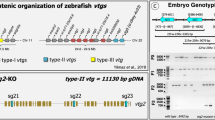Abstract.
During the final step of Drosophila vitelline membrane formation, the structural proteins composing this layer become cross-linked by covalent bonds. In the present report, we analyzed the vitelline membrane cross-linking in mutants having defects either in this layer or in the chorionic layers. In the fs(1)Nasrat and fs(1)polehole mutant alleles conferring defects in vitelline membrane formation, disruption of vitelline membrane cross-linking was observed, indicating the involvement of these two genes in the process. On the contrary, in the fs(1)Nasrat and fs(1)polehole alleles showing defects only at the termini of the embryo the vitelline membrane is properly formed, confirming a multifunctional activity of their gene products. Altered vitelline membrane cross-linking was also detected in a mutant of the chorion protein gene Cp36 and in the chorion amplification mutant fs(1)K1214, suggesting a role of the structural components of chorion layers in the process of vitelline membrane hardening.
Similar content being viewed by others
Author information
Authors and Affiliations
Additional information
Electronic Publication
Rights and permissions
About this article
Cite this article
Cernilogar, F.M., Fabbri, F., Andrenacci, D. et al. Drosophila vitelline membrane cross-linking requires the fs(1)Nasrat, fs(1)polehole and chorion genes activities. Dev Genes Evol 211, 573–580 (2001). https://doi.org/10.1007/s00427-001-0192-1
Received:
Accepted:
Published:
Issue Date:
DOI: https://doi.org/10.1007/s00427-001-0192-1




